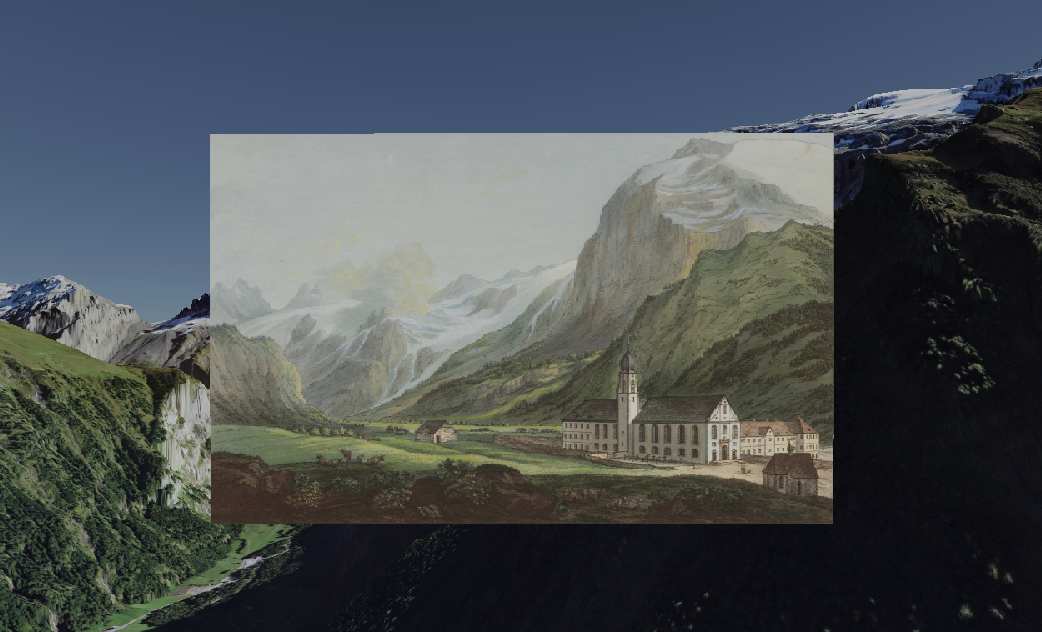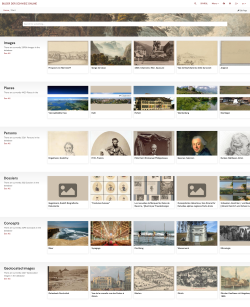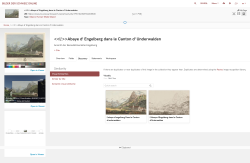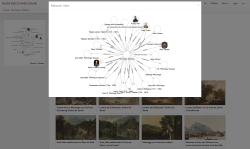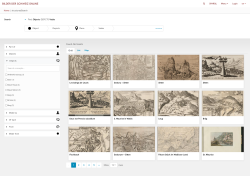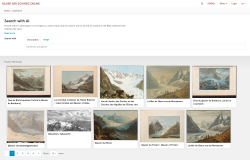Switzerland through the lense of topographic art and photography from the 18th to early 20th century
For this #LTMThursday we have the pleasure to shed some light on the project Images of Switzerland Online developed as a collaboration between the Swiss Art Research Infrastructure (SARI) and the Chair of Modern Art History at the University of Zurich (UZH). They are jointly creating an online portal to research and present the historical view on Switzerland as it appeared in topographic art (drawings, prints) and photography from the 18th to the early 20th century.
What is the key ambition of your project “Images of Switzerland Online”?
In Bilder der Schweiz online (BSO), Images of Switzerland, we want to create opportunities for citizens to connect with their past to foster a sense of belonging in the present. For understanding, the images in our dataset are central. They are a data type with great power in evoking emotional responses. When seeing our images, our users get a sense of how the landscape around them, and the ways it got depicted, changed over the past three hundred years.
Our scientific ambition is to establish a network of information from the rich archives of Swiss collections, libraries, archives, and museums. Users should be able to discover parallels among the diverse data collection. We deem this networked approach necessary because no matter the data provenance, information is related to recurring people, places, and concepts. Our target audience is the public interested in these materials. In particular, BSO aims to curate some of its findings into school lesson plans.
Was there an initial idea for the project or even a particular spark that birthed the idea for this project?
The project was initiated by Swiss Art Research Infrastructure (SARI) and the Chair for Modern Art History in 2019. That year marked the pivotal moment when SARI, which developed its technological infrastructure as part of the Swiss State Secretariat for Education, Research and Innovation (SERI)’s Roadmap of Research Infrastructures of National Relevance (2017–2020) turned operational. The availability of such a qualitative infrastructure working with linked data and semantic technology opened a window of opportunity for the study of Helvetica (‘Swiss Views’, see below). Furthermore, as metadata on these would be sourced at different institutions, linked-data technology promised to reveal the numerous insights in these collections.
What kind of archival material does your project focus on? Which institutions hold the relevant material?
Helvetica, Images of Switzerland, are works in print, photography, or drawing that document the ever-changing Swiss landscape between ca. 1700-1950. A particular focus among the collection of these works is the print designs created by “Schweizer Kleinmeister”, Swiss minor masters. However, we also include sketches, prints and drawings from unknown individuals. By including objects beyond the most well-known works, BSO refines our perspective on Switzerland in the past. Such an understanding diversifies our perspective on the past. The institutions holding relevant materials that we include are the Zurich Central Library, the Swiss National Library, the Cabinet d’arts graphiques (Prints and Drawings) at the Musée d’art et d’histoire Geneva, and our funder, the Fehlmann Family Foundation. As for reference data, we try to integrate additional local and global datasets such as GND (integrated authority file), Wikidata or SIKART (Lexicon of Art in Switzerland).
Is this material already available digitally or does it need to be digitized first?
BSO has amazing project partners who provide us with digitized images and metadata! The materials we work with were already digitized at Swiss institutions. On our side, we enrich and enhance this data. This presents a win-win for our project partners: we work with their unique collections, and they benefit from the data curation we conduct on the dataset. An example of this is aligning historical and current place names, automated attributing individual prints to dossiers, or correcting minor spelling errors. We are delighted that part of the images we work with are available as IIIF manifests.
Are you possibly planning to include material from private archives as well?
While we work with libraries and museums, we also include the collection of our funders, the Fehlmann Family Foundation (Stiftung Familie Fehlmann). This allows us to create a pipeline that works for small and large collections. Furthermore, the project is set up to enable the integration of further collections, including private archives.
Tell us a bit more about how your online portal enables users to get a glimpse of historical Switzerland.
We use semantic web technology to connect source data and enrich it with research data and information. When you access our research portal, you can look at records from different angles: object records are displayed along conceptual groupings, place clusters, people-centered networks, and other curated bundles of information. You can use a similarity-based algorithm for discovering similar views or explore a graph visualization of how two images connect. This helps art historians understand how images have been made – for example, when they see different variants of one design as a sketch, etching, and colored print. While our research platform allows insights into the data, the portal planned by the Chair for Modern Art History will curate some case studies into bundles of information. Those will thematize topics like infrastructure development, environmental history, or artist portraits.
How would you explain the technical aspects of your portal to a non-expert audience?
Everything is linked; it’s possible to explore the collection by browsing from image to image via persons, places, topics, and techniques and discover related material in external data sources. We harmonize the data for that it’s easy to locate; for example, we group works by the same artist across collections. This is not trivial, as the same artist may go by different names, or the same name may refer to various artists. Particularly in painter families whose sons carry the same names as their fathers. And as a user in multilingual Switzerland, you’d also expect to access information in different languages. So, making all the bits talk to each other by building informational bridges from one placename to the other. When you can search, let’s say, for Basel but also find Bâle and Basle, that’s a significant gain.
Who are your current project partners and are you seeking to expand your network of cooperation partners?
We are funded by the Stiftung Familie Fehlmann, whose collection we include on our platform. Further project partners are the Zurich Central Library, the Swiss National Library, and the Musée d’art et d’histoire. A technical project partner is the project sMapshot at HEIG-VD. With these colleagues, we work on mechanisms for georeferencing artistic views and photographs within a three-dimensional map of Switzerland. We are so grateful for their volunteers’ work locating the images! You can see some of the views embedded in three-dimensional landscapes on our BSO research platform.
While we near the end of this project phase, we are very interested in developing follow-up or new projects with cooperation partners. Get in touch with one of us via email, follow us on Twitter and Youtube, and check sari.uzh.ch for the project and technology services we offer as part of our SARI Technology Platform Infrastructure – as SARI TPF, we can offer our services to your mandates, too!
Would you like to share a specific challenge/surprise you met along the way of the project?
As with any project working with large amounts of data, surprises are never too far! In our case, however, the challenges inspired us to develop solutions that would take our research project one step further. We faced challenges in two main areas: content and workflow.
Regarding content, as expected, the drawn views created by artists sometimes hundreds of years ago do not always fit reality. In some cases, the landscape itself has changed – think rivers taking different courses, cities expanding, or glaciers disappearing. On that note – the rate with which glaciers disappear is shocking. The Grindelwaldgletscher, for example, one of Switzerland’s biggest glaciers depicted in such amazing prints and drawings from the eighteenth century, has almost disappeared today. That makes you wonder how the landscape will look in another century… But in any case, we incorporate such conceptual layers of information about the past into the time machine we are building with our BSO research platform.
Regarding our workflow, we made discoveries in our data that were also valuable for the collection holders. When we turn a collection into semantic data, we capture its meaning with our models. In establishing such meaning, we collaborated with our project partners. Our discussions made them reflect on some of their cataloguing decisions. Finally, we have also learned that working some of the time remotely is no issue at all – we have a team that works very well in and out-house!
Anything else you would like to share about your project with our community?
We believe that Digital Heritage projects are built on collaborative efforts. The scientific and interpersonal networks surrounding us are our project’s fundamental context: We have developed BSO within and for our communities. Discussing with you and learning from your questions and the ideas you shared leads to continuous refinement of our workflows and infrastructure. Thank you!
Thank you as well for this informative interview highlighting the many facets of your project. We are looking forward to seeing where it is going and will be happy to share any future news and developments with our Time Machine community!
To delve deeper into this project, you can try out the online platform yourself and also check out the YouTube channel of the Swiss Art Research Infrastructure (SARI) to learn more about the various aspects (IIIF implementation etc.) of Images of Switzerland Online.
Images of Switzerland Online: User interface
Click images to view in full
